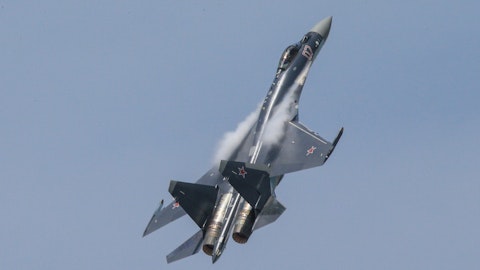But again, doing the best we can to come up with a fair set of compensation structures to help out during these trying times. And then, of course, communicate with them consistently about what we’re seeing in terms of the assumptions that we’re talking about here. Full life incorporation, MRO, MRO output, all the things that are going to drive better fleet support for them. So obviously don’t want to be in a position where we’re putting our customers in harm’s way and where they’re going to be very upset with us and want to take action. But I’ll tell you, we’ve got a track record of coming to agreement with our customers on some of the more difficult problems we’ve faced. I’m confident we’re going to be able to do it again.
Doug Harned: And if I can, are you seeing any improvement in the time, the induction time to get these engines in the shop as part of this AOG profile?
Chris Calio: Right now, Doug, the wing-to-wing turnaround time remains consistent with what we had talked about previously. I will tell you, and we kind of alluded to this earlier, we are continuing to aggressively pursue with our aftermarket partners. Again, we’ve got some Tier 1 aftermarket providers as part of the GTF aftermarket network trying to come up with, you know, what I would call light or medium type work scopes that can take the, you know, in shop time, down further. Again, trying to maximize the time on wing, just depends on the operator, depends on the condition of the engine, but we’re aggressively pursuing a number of work scopes that can take the in-shop time down. In addition, I think you’ve heard us talk about this before, we’ve industrialized a significant number of repairs on the GTF, I want to say about 1,300 in 2023. We’ve got another significant step up here in 2024 [Technical Difficulty]
Operator: Thank you. Our next question comes from the line of David Strauss of Barclays. Your question, please, David.
David Strauss: Thanks. Good morning.
Chris Calio: Good morning.
David Strauss: Wanted to ask, what exactly is the bottleneck, Chris, to be able to ramp up production of full-life discs, given that I think the powdered metal switch occurred a while ago I guess I’m just kind of confused there why it’s not easier to ramp up the production of these full-life discs? And then could you touch on what you’re expecting for large commercial engine deliveries in ‘24 and your confidence in being able to meet Airbus’s requirements? Thanks.
Chris Calio: Sure. So, you know, as we talked about, David, the powdered metal value stream, we’re asking it, both our own shops and our supply chain, to step up significantly here so that we can incorporate into MRO, as we talked about earlier, and in OE. So much more than that value stream clearly had anticipated mid-year last year. Again, we feel like we’ve got pretty adequate forging capacity within our own four walls and with the supply chain. But again, we’ve got to continue to ramp up inspection capacity. We’ve got to ramp up machining capacity, all critical parts of that value stream. And I’ll tell you, as you ramp up, and we saw this in 2019 as we were ramping and we’re ramping up again here, as you take these parts to a volume that our supply chain wasn’t necessarily anticipating and that we weren’t necessarily anticipating, you’ve got to continue to double down on the fundamentals, the quality, the yield, the tooling, and the maintenance, all the things that are instrumental in enabling that volume jump.
So, again, I would say we’ve made solid progress thus far in our, you know, generally tracking to where we thought we would be. But again, we’ve got to continue to step up throughout the year, especially as we want to increase the number of full life parts we put into MRO. To your question about Airbus, I think Neil said it before, up about 20% year-over-year here in ‘24. And again, we have discussions with Airbus all the time. They understand the fleet condition. They understand where we’re ramping on powdered metal parts and the like. And so, we feel good about our ability to meet the commitment we made to them here in 2024.
David Strauss: Thanks very much.
Operator: Thank you. Our next question comes from the line of Ronald Epstein of Bank of America. Please go ahead, Ronald.
Ronald Epstein: Hey, good morning, guys.
Chris Calio: Good morning, Ron.
Ronald Epstein: Just change the subject a little bit. Everybody seems to be talking about the powdered metal thing. And Collins, Collins outlook looks really good. Can you give some color around how much of that is being driven by widebody and interiors and if you’re starting to really see a pickup there. Because the one thing that we’re all kind of waiting for is the pickup in the widebody market. And that interior’s business is generally a good leading indicator of what’s going on.
Greg Hayes: Let me start, Ron, and maybe Chris can add something. Let me give you a couple details first. On the aftermarket side at Collins, we expect that to be up high-single-digits to low-double-digits, I’d say 10% or more. On the OE side, mid to high-single-digits. And we’re going to see, as everyone knows, about 40% incrementals there. And yes, wide body is going to be a big driver. So as we’ve seen a lot of narrow body, I’ll call it catch up in growth over the last couple of years, we do expect that to shift to the widebody. Now keep in mind on the widebody OE side for Collins, the margins are a bit thinner there, but it does set us up for good longer term projections, especially as you get into ‘25 and ‘26 and beyond, as that comes off warranty and converts to aftermarket.
Around the interior business, I think Steve Tim had said this back in June, that business is growing, but it’s nowhere near levels of 2019. And so we don’t see that coming back until about 2026. So the good news is, you know, there’s a lot of runway there. And we are seeing a lot of activity there. So I think that will be a growth driver. But clearly, we’re starting to see a bit more of a shift from narrow body into wide body as we go into the next couple of years.
Chris Calio: Yes, maybe the only thing I would add to that, Ron, is that Steve and team are very focused on the transformation within interiors. I think there’s some opportunity to consolidate sites, to continue to remove ERP systems. As you know, there’s been an integration that’s been going on in that interiors business in particular. So I think a lot of good work on continuing to transform the cost footprint in the interiors business. So when that volume continues to come back, it’ll be at the types of margins that you would expect.





